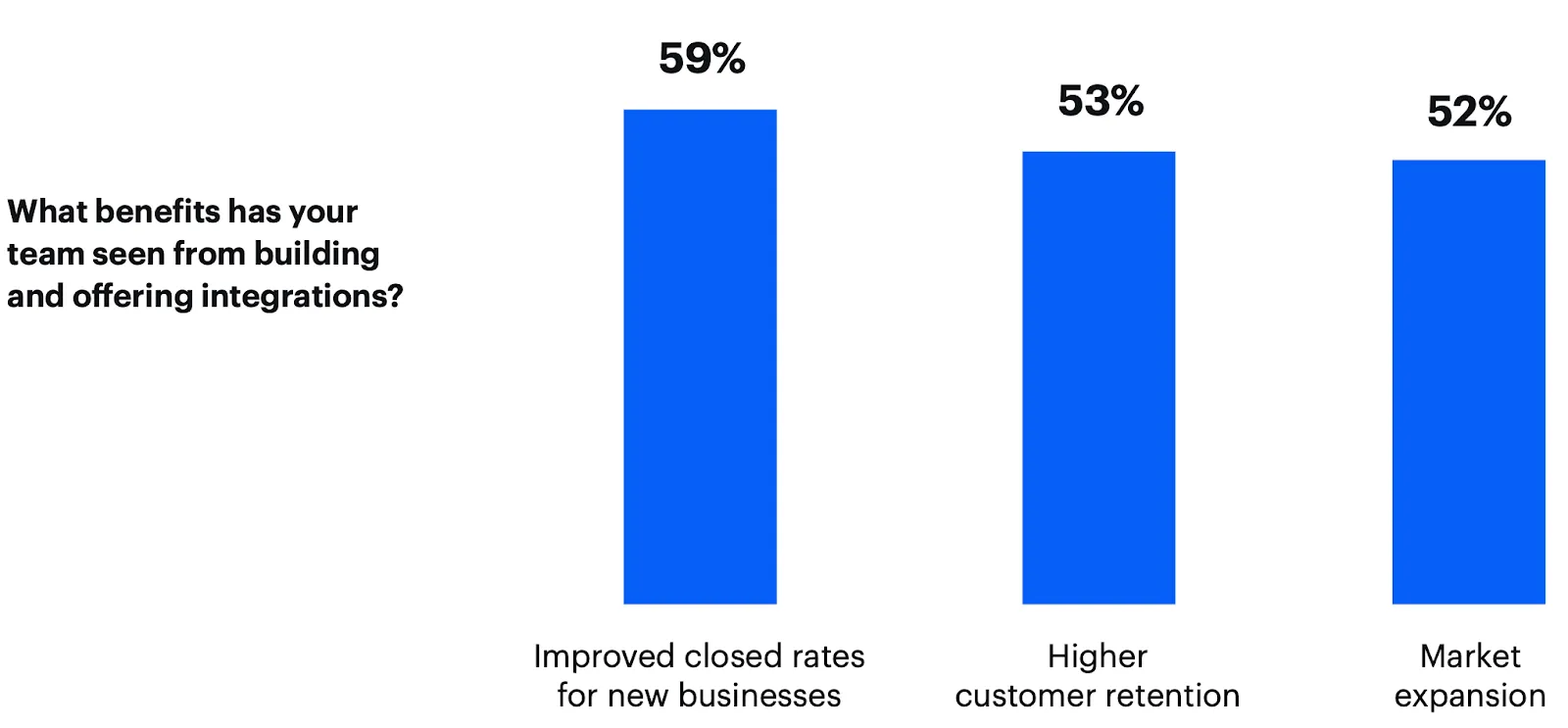Table of contents
SaaS integration strategy: how to develop yours from scratch

Your organization can benefit from having customer-facing integrations in a variety of ways.
Case in point: According to our “State of Product Integrations”, more than half of the product managers and engineers we surveyed (out of 260) cite improved close rates, higher customer retention, and successful market expansions as the benefits they’ve experienced from offering customer-facing SaaS integrations.
But realizing these benefits isn’t guaranteed. You’ll need to adopt a thoughtful and comprehensive approach to building, marketing, selling, and supporting your SaaS integrations. In other words, you’ll need to develop and execute an effective SaaS integration strategy.
We’ll help you do just that by walking through all the steps you’ll need to take.
Identify your top goals from offering integrations
As our research highlighted, SaaS integrations can help your organization in a variety of ways.
Being able to prioritize these benefits for your business can help you determine the specific integrations you should build short-term—versus long-term.
For instance, if your top priority is to improve customer retention and you notice that clients that churn often cite specific integrations as the reason they’re leaving, your organization should—all else equal—build those integrations first; while if your top goal is to expand into a new region and you find that companies in the region tend to use certain applications in categories that complements yours, you’ll likely want to prioritize integrating with those applications.
It’s also worth noting that your business' goals will likely vary over time, which should influence the integrations your team wants to implement. With that in mind, it’s worth re-assessing your integrations' goals on a consistent cadence—say every 6 months.
Decide on your approach to building and maintaining integrations
You generally have 3 options for building product integrations:
The option you choose largely depends on the integrations you decide to build (which you can determine from the previous section).
If there are only a few integrations that you need to build and maintain over time and you have enough engineering resources available, it may be worth implementing the integrations in-house.
Similarly, if you have just a few integrations to build and maintain and your engineers are already familiar and comfortable with using an embedded iPaaS, then it can make sense to use this type of solution.
That said, if you have a high volume of integrations you need to build and maintain, it’s likely in your best interest to leverage a unified API solution.
Reason being, the solution lets you offer hundreds of integrations via a single API build, which makes the platform incredibly effective at scaling your integrations.
Note: Even if your organization doesn’t need to build many integrations today, that can quickly shift based on changes in your clients’ or prospects’ wants and needs. With that in mind, it may be worth adopting a unified API solution today so that you can quickly adapt if needed in the future.
Ready to scale your product integrations?
Learn how Merge can help you add hundreds of product integrations across SaaS categories in a matter of days.

Align on your go-to-market strategy
Building integrations is just one piece of the puzzle.
You also need to raise awareness of them so that your prospects and clients can go on to evaluate and potentially adopt them. Moreover, you need to be able to pinpoint the appropriate price point and support model so that the integrations provide a meaningful ROI for your business.
There’s no one-size fits all approach for handling these areas; we’ve seen several clients tackle them in different ways.
For instance, in the case of awareness, allwhere—an IT asset management platform for distributed teams—has seen success in getting sign ups by sending out an email to clients that announce their HRIS integrations and their use cases.
While our other clients, like Avenue—a smart ticketing platform for operations teams—has seen success with announcing their integrations, explaining why they’re useful, how they can be set up, and more via blog posts.
In the case of pricing, we’ve also seen a variety of approaches work for different businesses.
Some clients, like Apiday—a sustainability platform—offer integrations for “free” as the increase in retention driven by their integrations outweighs the costs of providing and maintaining them. On the flip side, we’ve seen clients, like Causal—a financial planning tool—provide more integrations for higher tiered plans and, for integrations purchased a la carte, charge different price points across software categories.
Execute a best-in-class product integration strategy with Merge
Merge, the leading unified API solution, lets you offer hundreds of customer-facing integrations across key software categories by building to its unified API—ensuring that you can meet your business’ integration goals over time.
In addition, our customer success managers can help you craft personalized and impactful go-to-market strategies to ensure that your integrations deliver a high ROI for your business and your clients.
Ready to scale your product integrations?
Learn how Merge can help you add hundreds of product integrations across SaaS categories in a matter of days.













.png)

